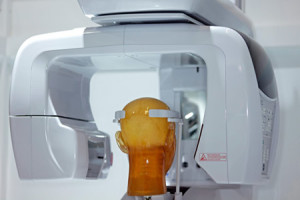Cone Beam Computed TomographyAug 07 2014
 Cone-beam computed tomography, also known as CBCT, is on the rise in the world of dentistry because it’s considered a newer, more effective method of imaging. The cone-beam technology works to reconstruct a 3D image of the head and it can be focused on the teeth, mouth, jaw, and neck, or the ears, nose, or throat. This technology has been around since the early 2000s and has become increasingly common in dentistry offices across the country, however, there are many practices that continue to use outdated technology. The patient stands inside and steadies themselves while the machine spins around the patient to capture the image. This in-depth, exact imaging provides an intimate view of hard-to-reach areas inside the mouth. Abnormal teeth and endodontic abscesses can be diagnosed with this clear technology. It’s completely non-invasive and provides a more complete view that a simple 2D image cannot compare with. There is a small risk of radiation with the CBCT imaging style but it is far lower than CT exams or the conventional dental x-rays. Although the risk still does remain it is a much healthier option for patients who are worried about radiation exposure. The clarity and functionality of the CBCT images greatly outweigh any other imaging options and the risk of radiation is actually lowered compared to more outdated technology. The technology is nearly 15 years old and it’s any wonder why some dental offices continue to ignore it and offer patients insufficient imaging services.
Cone-beam computed tomography, also known as CBCT, is on the rise in the world of dentistry because it’s considered a newer, more effective method of imaging. The cone-beam technology works to reconstruct a 3D image of the head and it can be focused on the teeth, mouth, jaw, and neck, or the ears, nose, or throat. This technology has been around since the early 2000s and has become increasingly common in dentistry offices across the country, however, there are many practices that continue to use outdated technology. The patient stands inside and steadies themselves while the machine spins around the patient to capture the image. This in-depth, exact imaging provides an intimate view of hard-to-reach areas inside the mouth. Abnormal teeth and endodontic abscesses can be diagnosed with this clear technology. It’s completely non-invasive and provides a more complete view that a simple 2D image cannot compare with. There is a small risk of radiation with the CBCT imaging style but it is far lower than CT exams or the conventional dental x-rays. Although the risk still does remain it is a much healthier option for patients who are worried about radiation exposure. The clarity and functionality of the CBCT images greatly outweigh any other imaging options and the risk of radiation is actually lowered compared to more outdated technology. The technology is nearly 15 years old and it’s any wonder why some dental offices continue to ignore it and offer patients insufficient imaging services.